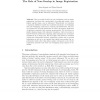Free Online Productivity Tools
i2Speak
i2Symbol
i2OCR
iTex2Img
iWeb2Print
iWeb2Shot
i2Type
iPdf2Split
iPdf2Merge
i2Bopomofo
i2Arabic
i2Style
i2Image
i2PDF
iLatex2Rtf
Sci2ools
IPMI
2005
Springer
2005
Springer
The Role of Non-Overlap in Image Registration
Here we model the effect of non-overlapping voxels on image registration, and show that a major defect of overlap-only models--their limited capture range--can be alleviated. Theoretically, we introduce a maximum likelihood model that combines histograms of overlapping and non-overlapping voxels into a common joint distribution. The convex problem for the joint distribution is solved via iterative application of replicator equations that converge monotonically. We then focus on rigidly aligning images with unknown translation, where we present a fast FFT-based method for computing joint histograms for all relative translations of an image pair. We then apply this method to standard overlap-only information theoretic registration criteria such as mutual information as well as to our variants that exploit non-overlap. Our experimental results show that global optima correspond to the correct registration generally only when non-overlapping image regions are included.
IPMI 2005 | Joint Histograms | Medical Imaging | Non-overlapping Image Regions | Non-overlapping Voxels |
| Added | 16 Nov 2009 |
| Updated | 16 Nov 2009 |
| Type | Conference |
| Year | 2005 |
| Where | IPMI |
| Authors | Jonas August, Takeo Kanade |
Comments (0)

